ASM Metals HandBook Vol. 8 - Mechanical Testing and Evaluation
Подождите немного. Документ загружается.

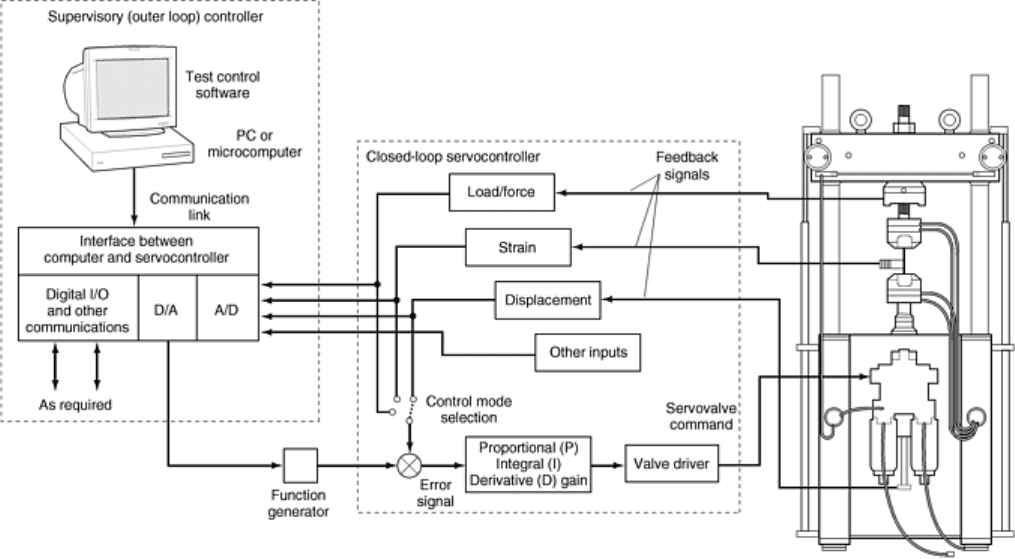
needs. Some systems provide the ability to build test sequences that are limit programmed (e.g., a load-
controlled, strain-limited waveform), can offer multimode test control (e.g., dynamically switching control
modes during the test), and can provide the ability to perform calculated control of either or both the control
variable, as well as the significant waveform parameters (e.g., amplitude, rate, and frequency) (Fig. 18).
Examples of the testing applications that can be accomplished with this class of testing software include TMF,
biaxial and multiaxial fatigue, creep-fatigue, and bithermal fatigue. These general-purpose systems have grown
in sophistication to the point where one must carefully consider one's testing needs before embarking on a
custom-application programming project; often, the general-purpose system can provide the quicker solution
and at a much more attractive cost.
Fig. 18 Typical supervisory (outer loop) calculated-variable controller system for fatigue testing
Custom-Application Software. When testing requirements are very specific and unique, materials testing
engineers must often develop their own materials testing application software. The approach taken can vary
widely depending on the nature of the test controller and the needs of the application.
Data Acquisition Requirements. Regardless of the approach taken with respect to testing software, certain data
acquisition requirements must be met with regard to the amount of data collected, the rate of collection, and the
overall accuracy of the data collected. Fatigue tests involving the use of sinusoidal waveforms (commonly used
for high-cycle fatigue testing), for example, typically require a data collection rate of fifty points per cycle to
enable the cycle to be accurately rendered. A triangular waveform is most often used for low-cycle fatigue
testing. Accurately rendering a hysteresis loop in this case requires a data collection rate of up to four hundred
points per cycle. When selecting or evaluating data acquisition capabilities for fatigue testing, consideration
must also be given to the specific properties of the analog/digital (A/D) system: important characteristics
include resolution, accuracy, and noise level. Another important characteristic concerns how the A/D system
handles multichannel signal input. Typically, two approaches are taken. The first and most common approach is
to simply multiplex the input signals to the A/D system. A concern here is the potential for channel-to-channel
data skew: each channel scanned is obtained at a different time than the others. Depending on the conversion
rate of the A/D system and the testing frequency being employed, the channel skew can be significant. A
second approach for handling multichannel inputs is to use a simultaneous sample and hold amplifier for each
channel. In this approach, all channels are sampled and held at the same time and are then multiplexed to the
A/D for conversion. Yet other data acquisition systems employ individual A/D converters for each input
channel (see ASTM E 1856 for a more detailed discussion of this topic).
Data Analysis. The software available for data analysis largely mirrors that available for testing applications;
the standardized test applications generally have built-in data analysis and reporting capabilities, optimized to

report test results in standardized formats. However, test data obtained from general-purpose testing software,
and especially data obtained from custom-application programs, must generally be imported into a data analysis
program. The most common data analysis programs are the scientific data analysis and plotting applications
widely available from many vendors. Another popular method is to import test data into spreadsheet programs.
Many of the scientific analysis packages (as well as the spreadsheet programs) provide the ability to develop
reasonably sophisticated analysis algorithms (“macros” in spreadsheets, for example), thus providing a
convenient and powerful means of data analysis and presentation.
References cited in this section
26. A.A. Braun, “A Historical Overview and Discussion of Computer-Aided Materials Testing,” ASTM
STP 1231, Automation in Fatigue and Fracture: Testing and Analysis, C. Amzallag, Ed., American
Society for Testing and Materials, 1994, p 5–17
27. S. Dharmavasan, D.R. Broome, M.C. Lugg, and W.D. Dover, FLAPS—A Fatigue Laboratory
Applications Package, Proc. 4th Int. Conf. on Engineering Software, R.A. Adey, Ed., Springer-Verlag,
London, 1985
28. A.A. Braun, The Development of a Digital Control System Architecture for Materials Testing
Applications, Proc. 17th Int. Symposium for Testing and Failure Analysis, ASM International, 1991, p
437–444
29. S. Dharmavasan and S.M.C. Peers, “General Purpose Software for Fatigue Testing,” ASTM STP 1231,
Automation in Fatigue and Fracture: Testing and Analysis, C. Amzallag, Ed., American Society for
Testing and Materials, 1994, p 18–35
30. M.A. McGaw and P.J. Bonacuse, Automation Software for a Materials Testing Laboratory, Proc.
Turbine Engine Hot Section Technology (HOST), NASA CP-2444, National Aeronautics and Space
Administration, 1986, p 399–406
31. M.A. McGaw and P.J. Bonacuse, “Automation Software for a Materials Testing Laboratory,” ASTM
STP 1092, Applications of Automation Technology to Fatigue and Fracture Testing, A.A. Braun et al.,
Ed., American Society for Testing and Materials, 1990, p 211–231
32. M.A. McGaw and P.A. Bartolotta, The NASA Lewis Research Center High Temperature Fatigue and
Structures Laboratory, Proc. 4th Annual Hostile Environments and High Temperature Measurement
Conf., Society for Experimental Mechanics, 1987, p 12–29
33. M.A. McGaw, materials testing software LEW-16160, COSMIC, 1995
34. J. Christiansen, R.L.T. Oehmke, and E.A. Schwarzkopf, “Materials Characterization Using Calculated
Control,” ASTM STP 1303, Applications of Automation Technology to Fatigue and Fracture Testing,
A.A. Brown and L.N. Gilbertson, Ed., American Society for Testing and Materials, 1997
Fatigue, Creep Fatigue, and Thermomechanical Fatigue Life Testing
Gary R. Halford and Bradley A. Lerch, Glenn Research Center at Lewis Field, National Aeronautics and Space Administration; Michael
A. McGaw, McGaw Technology, Inc.
Baseline Isothermal Fatigue Testing
It is important to understand the underlying purposes of the testing to be performed. This understanding will aid
in selecting a fatigue testing machine and specimen design. Normally, a baseline condition is established from
which effects on fatigue life of a wide variety of variables might be assessed. Laboratory ambient conditions of
room temperature, atmospheric pressure, and humidity are a commonly accepted condition for baseline testing;
however, other choices of, for instance, temperature may be more appropriate. Baseline testing is usually
performed with the numerous fatigue life-influencing variables held constant at what would be considered
“default” conditions. For example, completely reversed loading (zero mean stress) may be used, or perhaps
zero-to-maximum loading is preferred owing to the nominal zero-to-maximum loadings expected in service.
Note that rotating-beam machines are incapable of mechanically imposing mean stresses. If mean stress
assessment is contemplated for testing beyond the baseline, a different type fatigue machine is required.
The acquired baseline database may have value in serving any of several diverse purposes:
• Ranking fatigue resistance of alloys
• Performing micromechanistic studies
• Guiding development of fatigue-life prediction models
• Collecting statistical documentation
• Establishing fatigue design curves
• Conducting failure analysis
Testing Regime. Of additional importance is the fatigue-life regime of interest—low-cycle or high-cycle
fatigue. As discussed earlier, the amount of time available for testing, along with the number of companion
machines and their cyclic frequency capability, will dictate which type of machine is best suited for the task at
hand. For fatigue lives far beyond 10
5
, a high frequency of testing is a necessity. However, at lives well below
10
5
, high frequency is a liability, not an asset. With the exception of very high cyclic lives, servohydraulic
direct-stress testing machines offer the greatest possible versatility in testing machines today. Specially
designed, and hence costly, commercially available servohydraulic machines can achieve 1000 Hz.
Calibration and Standard Test Procedures. Once equipped with an appropriate fatigue testing machine and a
specimen design, it is important to follow applicable standards for testing (e.g., ASTM and ISO standards). The
major items covered by ASTM standards include calibration of, for example, load cells, extensometers, other
sensors, read-out equipment, and recorders for data storage; alignment of the loading axis of the testing
machine with grips and with the test specimen; specimen design, including alignment of the test section with
grip ends; surface finish; material quality control from specimen to specimen; and purity of loading command
signals. Table 1 lists the currently applicable ASTM standards for baseline (and associated) fatigue testing.
Adhering to testing standards is particularly important in fatigue testing due to the inherently high degree of
scatter in fatigue resistance. In creating the standards, efforts were made to ensure uniformity of specimen
geometry, surface finish, loading alignment and gripping, temperature and humidity (for alloys sensitive to
moisture level), and uniformity in all aspects of the testing machine frame and loading train, its ancillary
equipment, controllers, recorders, data storage, and data manipulation.
Generating Fatigue Crack Initiation Data. The loading mode, life regime, test temperature and environmental
conditions, mean stress, surface finish, and heat treatment condition, among others, dictate the testing machine
and ancillary equipment required. Once these are in place and calibrated and the representative test specimens
have been prepared, a baseline fatigue testing program can be conducted. If the program involves several
variables, it is wise to first perform a design-of-experiments study to maximize the information to be obtained
while minimizing the number of tests and attendant costs. In any event, it should be noted that the cost of
specimen preparation is usually not the dominant cost in a fatigue testing program. It is wise to ensure that a
sufficient excess of specimens is made to more than adequately cover the initial number required in the
program. Having specimens left over from a baseline study is often beneficial, particularly if additional factors
are to be studied and if scatter in fatigue lives has been great enough to warrant additional tests to better
establish the statistical results. It is generally not possible to duplicate the specimen consistency at a much later
date, so it is better to have extra, rather than not enough, specimens to begin a test program.
It is advisable to estimate the expected fatigue life of any test prior to starting the test to avoid excessively long
or short test times. Past testing experience with similar materials is valuable in making life estimates. Empirical
equations have been published for estimating fatigue resistance based on conventional tensile test data for the
material, temperature, and environment of interest. The equations of Manson (Ref 35) and Morrow (Ref 36)
have proven invaluable in this regard (see Eq 1, which follows). In fact, the method of universal slopes (MUS)
has been used to bypass fatigue testing (Ref 35). With appropriate factors of safety, the MUS has been used in
the establishment of low-cycle fatigue design curves for many of the alloys used in the main engines of the US
space shuttle (Ref 37). The fatigue resistance of a large number of alloys in a variety of heat-treated conditions
over a range of temperatures and aggressive environments has been established in this manner.
If a broad range of testing times are to be involved, it is also advisable to conduct the shortest-time tests first,
then take advantage of these results to govern the loading levels applied for the longest-life tests. One should
avoid running tests that must be discontinued. Considerably less information is gained from such “run-outs.”
Sufficient tests should be run to failure over the range of variables studied to permit a statistical assessment of
the results. This is particularly true for the baseline results from which other fatigue test results are to be
compared.
The extent to which the test data are recorded during testing depends on the end use of the fatigue data. In high-
cycle fatigue, most alloys behave nominally elastically, and there is little reason to monitor test parameters
during the test, as there will be little (if any) change to observe until fatigue failure is imminent. However, in
strain-controlled low-cycle fatigue with observable amounts of plasticity, significant changes might occur that
warrant recording, for example, cyclic strain hardening or softening, relaxation of mean stress, and even cyclic
stress-strain response changes due to crack nucleation. It is quite important to be able to monitor these changes
during testing. For example, the hysteresis loop at “half-life” is usually chosen to be the representative loop of
the entire fatigue test. This loop provides the values of the stress amplitude, stress range, mean stress, total
strain range, inelastic (plastic) strain range, and the elastic strain range that are tabulated along with the number
of cycles to failure. Since the number of cycles to failure is not known until after the test has passed the half-life
point, it is necessary to monitor and record this information either continuously or at intervals close enough to
be able to interpolate to the half-life condition once the test has failed.
Baseline fatigue data are generally tabulated and plotted. Schematic fatigue curves (Ref 38) are shown in Fig.
19(a) for strong, tough, and ductile alloys. The corresponding stress-strain hysteresis loops are depicted in Fig.
19(b). This figure illustrates the common observation that the number of cycles to failure for a 1.0% total strain
range is approximately 1000 cycles, regardless of the strength or ductility level of an alloy when there is a
trade-off between strength and ductility due to different alloy processing. Presuming an equation form, fatigue
data can be analyzed using least-squares curve-fitting analyses. The most common equation form for low-cycle
fatigue and for lives to about 10
6
cycles is:
Δε
total
= Δε
clastic
+ Δε
plastic
= B(N
f
)
b
+ C(N
f
)
c
(Eq 1)
where, Δε
total
is the total mechanical strain range at half-life, Δε
elastic
is the elastic strain range (equal to Δσ/E) at
half-life, Δε
plastic
is the plastic (inelastic) strain range at half-life, N
f
is the number of cycles to failure, b is the
slope of elastic strain-range life line on log-log coordinates, B is the intercept of elastic strain-range life line at
N
f
= 1, c is the slope of plastic strain-range life line on log-log coordinates, C is the intercept of plastic strain
range life line at N
f
= 1, Δσ is the stress range at half-life, and E is the modulus of elasticity. The method of
universal slopes that is used to estimate fatigue curves has the same form as Eq 1. The values of the
“universalized slopes” are given by b = -0.12 and c = -0.60.
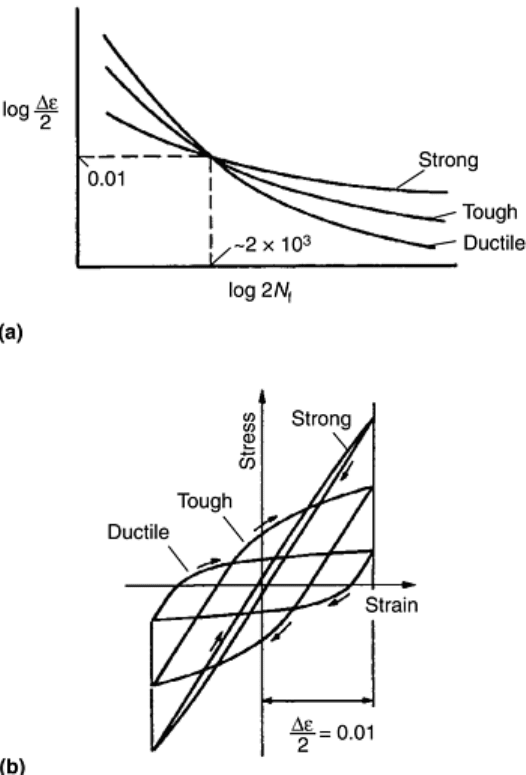
Fig. 19 Representation of the cyclic strain resistance of idealized alloys (strong, tough, ductile). (a)
Fatigue curves. (b) Stress-strain hysteresis loops. After Ref 38
The corresponding values of the intercepts are determined from conventional tensile test results for the alloy at
the temperature and environmental conditions of interest: B = 3.5σ
ult
/E and σ
ult
is the ultimate tensile strength,
and C = D
0.6
. True ductility (also true fracture strain) is abbreviated D; reduction of area in the tensile test is
abbreviated RA.
D = ln[(100)/(100 - %RA)]
Morrow's formulation is similar and has seen widespread use in the automotive and off-highway equipment
industries. It takes the following specific form:
(Δε
total
/2) = (Δε
elastic
/2) + (Δε
plastic
/2)
= (σ′
f
/E)(2N
f
)
b
+ ε′
f
(2N
f
)
c
(Eq 2)
where Δε
total
/2 is the total mechanical strain amplitude at half-life, Δε
elastic
/2 is the elastic strain amplitude
(Δσ/2E) at half-life, Δε
plastic
/2 is the plastic (inelastic) strain amplitude at half-life, 2N
f
is the number of
reversals to failure (2 × N
f
), b is the slope of the elastic strain-amplitude life line on log-log coordinates, σ′/E is
the intercept of elastic strain amplitude life line at 2N
f
= 1, c is the slope of the plastic strain-amplitude life line
on log-log coordinates, ε′
f
is the intercept of plastic strain amplitude life line at 2N
f
= 1, and Δσ/2 is the stress
amplitude at half-life.
Morrow's fatigue-life equation in its predictive form assumes the slopes and intercepts can be approximated
from tensile test properties by b = n/(5 + n), where n is the strain hardening exponent (the cyclic strain
hardening exponent, n′, may give better predictions; n′ = b/c; c = 1/(5 + n); and σ′
f
/E = σ
f
/E where σ
f
is the true
fracture stress (fracture load divided by fracture area). The true fracture strain is equal to the true ductility, D, is
equal to ε′
f
is equal to ε
f
.
The slopes and intercepts from the equations above are referred to as the basic fatigue properties. Reference 39
contains an extensive listing of these fatigue properties, along with corresponding tensile properties, for a wide
variety of steels, stainless steels, nickel-base superalloys, titanium alloys, aluminum alloys, weldments, and
castings. How the fatigue properties might be affected by factors that influence fatigue behavior is discussed in
the section “Testing for Effects of Variables on Fatigue Resistance” in this article.
In the high-cycle fatigue regime, that is, beyond approximately 10
6
cycles to failure, the log-log slopes of the
fatigue curves tend to become shallower than at lower life levels. For certain steels and selected body-centered
cubic (bcc) alloys, a fatigue or endurance limit of “infinite” life for cyclic stresses below the limit may be
observed in laboratory fatigue test results. Such limits may be erased by interspersed low-cycle fatigue loadings
that can break up the dislocation pinning by small interstitial atoms in the bcc structure. Under these
circumstances, the fatigue curve continues to drop in strength level below the original fatigue limit. Slopes of
the fatigue curve in the very-high-cycle fatigue regime may drop to -0.04 or less. Manson (Ref 40) has reported
ultrahigh-cycle fatigue life extrapolation procedures.
Criteria for Defining Fatigue Life. The first and most common definition of fatigue life for alloy testing is the
number of cycles of loading required for complete fracture of the specimen into two pieces. This definition is
unequivocal. It is easy to identify this terminal event in most fatigue tests. (During strain-controlled tests at low
strain amplitudes, cracking may reduce the stress level sufficiently so that the specimen never separates; in this
case, some other definition of failure must be used.) At fracture, the specimen grips are free to move apart,
allowing a mechanically activated switch to be tripped that stops the cyclic drive mechanism and the cycle
counter. Electrical continuity of the specimen is also broken permitting direct electrical switching of circuits
controlling the machine. Complete specimen separation is typically an acceptable measure of the crack
initiation fatigue life for high-cycle fatigue wherein the fatigue crack nucleation portion dominates the total life
(perhaps 90–99%). However, because the separation life does include a portion of cyclic crack growth, this
quoted life is somewhat larger than the number of cycles to physically initiate a crack. As the fatigue loading
levels increase and the cyclic lifetime decreases into the low-cycle fatigue regime, less and less of the life is
spent nucleating a crack, and more and more life is spent growing the crack(s) to the critical length for sudden
fracture into two pieces. To accurately define the cyclic crack initiation life, particularly in low-cycle fatigue,
one ideally would measure the actual crack size (depth and length) as cycling progressed. When a
predetermined crack size was reached, the number of cycles to “failure” would be noted and testing stopped.
Unfortunately, this is highly impractical for most testing because it cannot be implemented on an automated
basis for the large numbers of fatigue tests conducted annually.
The only practical definitions available are those based on measurements that are readily available from the test
instrumentation. This is usually in the form of changes in specimen elastic or plastic “stiffness” as determined
from stress-strain or load-deflection measurements. As a specimen develops a fatigue crack under completely
reversed strain control, its growth causes the load carrying response of the specimen to decrease. Different
degrees of drop in the cyclic load range for a fixed strain range have been used to define crack initiation failure
for low-cycle fatigue testing. The most commonly used criteria have been the very first indications of an
impending drop in the load range (i.e., impending cracking) and a 5% drop in the load range. Obviously other
percentage drops (10, 20, and 50) could be defined and used. Unfortunately, it may be difficult to distinguish
between load range drop due to cracking and load range drop due to cyclic strain softening of initially work
hardened materials. Even cyclic strain hardening could confound the measurement by offsetting the drop due to
cracking.
A logical way to separate the effects on load response of cyclic strain hardening or softening from cracking is to
track the ratio of the peak tensile load to the peak compressive load (Ref 41). If only hardening or softening
occurs, the load range will change, but the tensile/compressive load ratio will be affected very little. As fatigue
cracking progresses, the decrease in the tensile load amplitude exceeds that of the decrease of the compressive
load amplitude. This is observable in Fig. 20(a) from a load-versus-time trace for a low-cycle, completely
reversed, strain-controlled test (Ref 42). As cracking occurs, the change of the load ratio is almost twice as
much as the change in the load range, thus making it a more sensitive, as well as a more physically based,
measure of cracking. The load response would also be observable in a stress-strain hysteresis loop. In
compression, the crack faces close and carry load. This results in a cusp on the hysteresis loop near the
compressive peak. In tension, the peak load is carried only by the smaller, uncracked area.
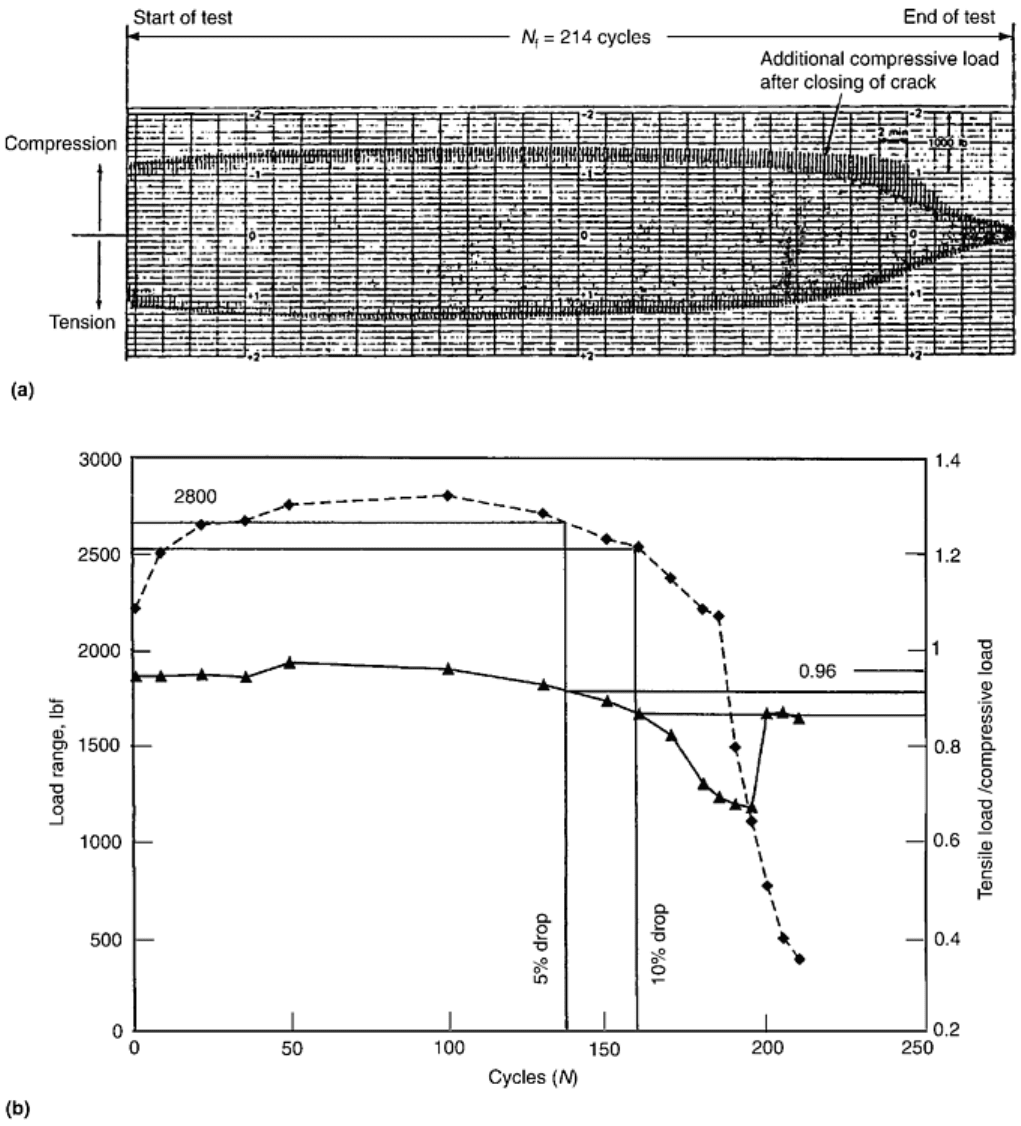
Fig. 20 Cyclic load response during strain-controlled low-cycle fatigue test of annealed AISI 304 stainless
steel in air at 816 °C (1500 °F). Total strain range, 3.26%, 0.056 Hz. (a) Cyclic load response for defining
cyclic life to crack initiation. (b) Cyclic load range and ratio of tensile to compressive peak load versus
applied cycles. Source: Ref 42
To apply these criteria for defining fatigue crack initiation life, the load ratio must be measured during the
precrack nucleation period. Note that the load ratio during this interval may not equal 1.00. It has been observed
to vary from as low as 0.9 to about 1.05 depending on material. The ratio, however, is nominally independent of
the amount of cyclic hardening or softening that occurs, and, hence, a greater duration of cyclic loading can be
used to establish the average value of the ratio before cracking commences. A graphic quantitative example is
given by Fig. 20(b) based on the data from Fig. 20(a). Both load ratio and load range are plotted versus applied
cycles. The load ratio is relatively constant at 0.96 for the first half of the test, but, by about 100 cycles, it
begins to drop steadily. At about 200 cycles, the ratio suddenly and inexplicably rises. This rise signals the end
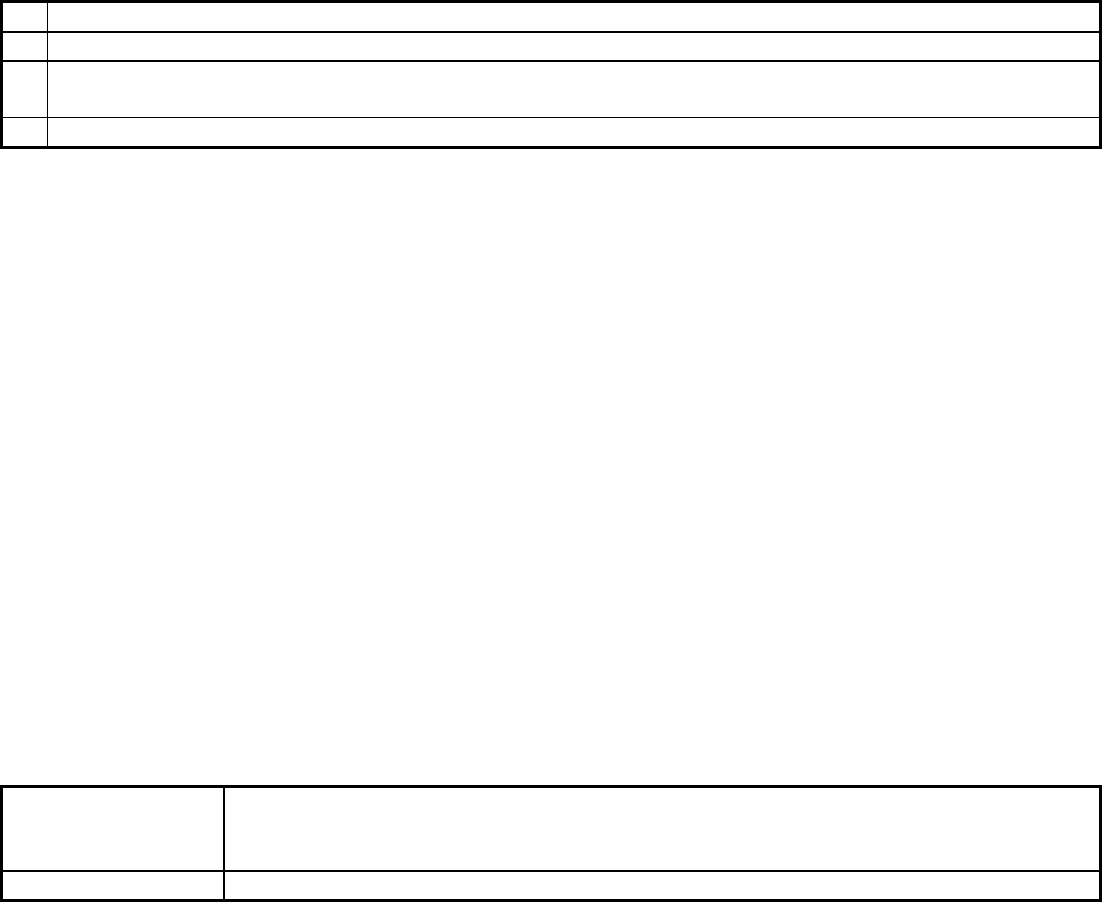
of useful information from the test. Even though the specimen is still in one piece, the computed stresses and
strains are no longer representative of what is going on in the gage length of the specimen. At this point, the
dominant crack has grown to a large fraction of the specimen diameter, and the extensometer is subjected to
large amounts of bending in addition to axial deformation. The specimen may not have failed completely, but
the test has. The corresponding load range is also shown. After considerable initial hardening of 25%, a half-life
(“stabilized”) value of 2800 lbf (12.5 kN) is reached. This is followed by an accelerating drop until complete
fracture of the specimen occurs at greater than 214 cycles. For the particular test data shown, the load ratio and
the load range follow approximately parallel behavior. For this example, a 5% drop in load range and load ratio
corresponds to the same number of cycles (~138 cycles). Similarly, a 10% drop in both gives approximately
158 cycles. In this case, either the load range or the load ratio drop criteria would give acceptable definitions of
fatigue crack initiation life. This is not expected to be the general case for the following reasons.
For a cyclically stable material with very little strain hardening within a hysteresis loop, a 5% load range drop
would correspond to approximately a 10% drop in the load ratio if the only reason for load drop were the
presence of a crack. This in turn would imply a 10% loss in specimen cross-sectional area if there were no
concentration of stress surrounding the crack tip. However, since there is a concentration of stress in front of the
crack, higher stresses are encountered there, thus increasing the tensile load-carrying capacity. Hence, a 10%
loss of area would actually correspond to less than a 10% loss of load ratio. Load ratios in the neighborhood of
5 to 8% have been noted.
With modern automated data recording and reduction, it is possible to determine the fatigue life by all of these
definitions, including complete fracture into two pieces. In this way, any definition of fatigue crack initiation
life can be selected for the purposes at hand. References 41 and 42 contain tabulated fatigue crack initiation
lives for several engineering alloys for the four criteria, as discussed above:
N
0
First indication of impending cracking
N
5
5% drop in load range from stabilized range (or at half-life value if stabilization does not occur)
N
i
10% drop in ratio of tensile to compressive load from stabilized range (or at half-life if stabilization does
not occur)
N
f
Complete separation of specimen
Similar criteria based on the same concepts could be established for completely reversed, load-controlled tests.
Instead of a decrease in load response due to cracking, an increase in strain or deflection response would be
measured to define fatigue crack initiation.
Care should be exercised in applying these criteria when multiple cracks initiate parallel to one another. Many
shallow cracks will have the same integrated effect on specimen gage length compliance as one deeper crack. In
addition, the exact location of the crack(s) relative to the contact points (defining the gage length) of the
extensometer can have an appreciable influence on the apparent (measured) compliance. For example, should
cracking initiate outside the gage section, the extensometer would not detect a change in compliance. Should
cracking initiate within the gage section, the load path would not necessarily remain along the centerline of the
specimen, and bending would occur. This, in turn, can cause the extensometer to register different outputs
depending on the plane of bending relative to orientation of the extensometer. These confounding influences
also affect the load range drop criteria for crack initiation.
Information to be Documented for Baseline Fatigue Tests. Guidelines are presented for what baseline fatigue
test information should be documented. Tables 2 and 3, respectively, provide comprehensive listings of
pertinent pretest and in-test/post-test information to be considered for inclusion. In preparing Table 3, it was
assumed that closed-loop; servostrain-controlled axial fatigue testing was the mode of operation. If other modes
of testing are used, the guidelines may have to be altered accordingly. Obviously, the information gleaned from
a fatigue test in progress will depend on the extent of instrumentation available, the type of testing machine, and
the mode of testing.
Table 2 Pretest information guidelines for baseline fatigue tests including studies of preexisting effects
on fatigue
Alloy designation
and description
Heat number and composition, forming processes, degree of anisotropy, heat treatment
and environmental preexposure conditions, final machining parameters,
photomicrographs, hardness, tensile properties
Specimen Drawing and specifications, orientation of axis to product form, accurately measured

configuration specimens dimensions (including notch description) and area of cross section (diameter
and area for direct stress mode of loading), surface finish and method of preparation,
final heat treatment, individual specimen indentification number, description of any
coating including any processing affecting the surface layer (preoxidation, prefretting,
galling, wear erosion, corrosion, carburizing, nitriding, anodizing, shot peening, laser-
shock peening, burnishing, and other means of introducing residual stresses, magnitude,
and sign of residual stresses, etc.), thickness, orientation of gripped specimen to testing
machine
Testing machine Designation of machine, type of grips, dates of last alignment and calibration of load
cell, types of heating and environmental control, type of extensometer, and date of last
calibration
Test engineer and
operator
Names and dates of set-up and start of test
Test mode, control
details, and test
conditions
Model of control (e.g., strain, load or deflection), cyclic frequency and waveform
including description of mean and alternating components, test temperature and mean of
measurement and control, relative humidity and nature of environment, starting date and
time error detector limits for shut-down, estimate of test duration and basis for estimate
Table 3 In-test and post-test information guidelines for baseline fatigue tests including studies of
preexisting effects on fatigue
Cyclically varying
parameters
Value of fixed test control parameters (e.g., stress, strain, or displacement);
continuous recording of variations of maximum, minimum, amplitude, range, and
mean values of stress and strain as a function of applied cycles; cycles variation of
load range variation and ratio of tensile to compressive peak loads to help define
failure life and help-life; continuous or periodic recording of variations of stress-
strain hysteresis loops
Lifetime
information
Cyclic failure lives based on various cyclic failure criteria; failure life (cycles and
corresponding time) for criterion adopted; half-life cycles; total, inelastic, and elastic
strain ranges at half-life; maximum, minimum, stress amplitude, stress range, mean
stress, and mean stress ratio at half-life; degree of cyclic hardening and/or softening
from first cycle to half-life (or cycles at stabilization of stress-strain response);
description of fracture surface including initiation site(s); location of fracture relative
to extensometer probes
Deviations from
original test plans
Details of stress and strain history immediately prior to controlled or uncontrolled
shut-downs prior to test completion
Data analysis
from multiple
specimens
Cyclic stress-strain curve and equation constants at half-life (or cycles at
stabilization), fatigue curves and equation constants (i.e., fatigue properties)
Example Crack Initiation Fatigue-Life Curves. Fatigue curves are displayed in a variety of forms, although
fatigue life is generally plotted on a logarithmic scale. The fatigue loading parameter is usually stress or strain.
Stress is most commonly plotted as stress amplitude, stress range, or maximum stress, and the scale may be
arithmetic or logarithmic. Examples are given in Fig. 21. These are referred to as S-N curves, and an indication
of the mean stress ratio should always be given. When strain is the fatigue loading parameter, the total (elastic
plus plastic), plastic, or the elastic strain ranges may be plotted. These are usually plotted on logarithmic scales,
as shown in Fig. 22, and are referred to as strain-life curves. Unless the fatigue strain cycling ratio is given, it is
understood that the curves represent completely reversed loading. The plastic strain-versus-life curve is known
as the Manson-Coffin (or Coffin-Manson) low-cycle fatigue curve. The elastic strain range-versus-life curve
has come to be known as the Basquin curve (Ref 43). The total strain range-versus-life representation of fatigue
data has its origins in the late 1950s and early 1960s. Coffin (Ref 44) originally represented the elastic strain
range-versus-life component of the total strain range-versus-life curve as a horizontal line with a strain range
value equal to twice the 0.2% offset yield strength divided by the elastic modulus. Langer (Ref 45) used the
same basic idea, but replaced the yield strength with the endurance limit strength. He went on to multiply the
total strain amplitude by the modulus of elasticity to compute the pseudo-stress amplitude. The resultant fatigue
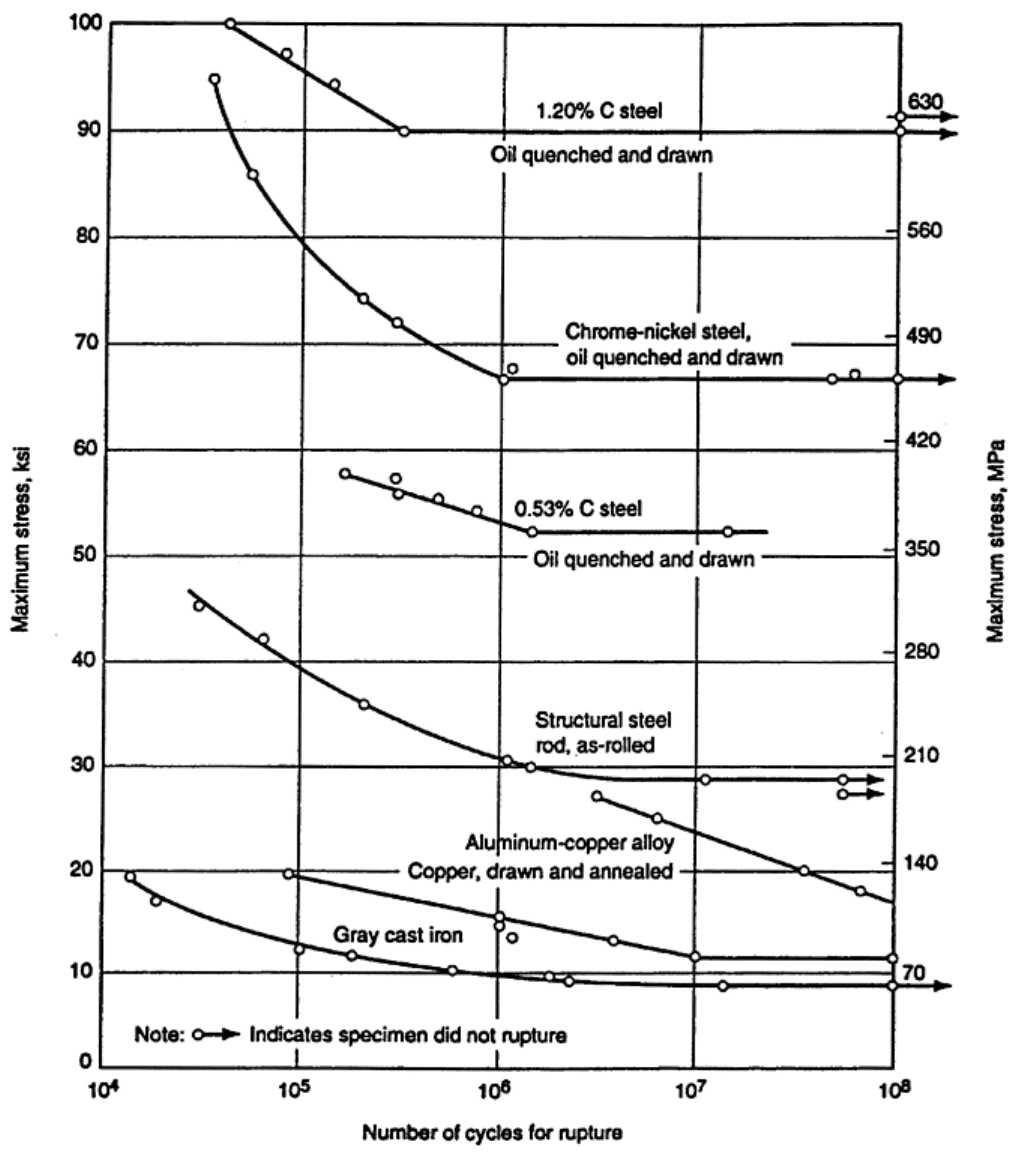
(S-N) curve could then be used in direct conjunction with elastic stress analyses. This representation was
adopted by the ASME Code, Section III, for Boiler and Pressure Vessel components.
Fig. 21 Typical S-N diagrams for various alloys subjected to completely reversed loading at ambient
temperature
